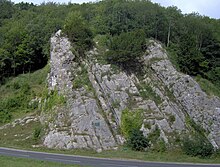Rock of Ages (Christian hymn)
| "Rock of Ages" | |
|---|---|

The Rock of Ages, Burrington Combe where the Rev Toplady is reputed to have sheltered from a storm
|
|
| Genre | Hymn |
| Written | 1763 |
| Text | by Augustus Montague Toplady |
| Melody | "Toplady" by Thomas Hastings |
Rock of Ages is a popular Christian hymn by the Reverend Augustus Montague Toplady written in 1763 and first published in The Gospel Magazine in 1775.
Traditionally, it is held that Toplady drew his inspiration from an incident in the gorge of Burrington Combe in the Mendip Hills in England. Toplady, a preacher in the nearby village of Blagdon, was travelling along the gorge when he was caught in a storm. Finding shelter in a gap in the gorge, he was struck by the title and scribbled down the initial lyrics.
The fissure that is believed to have sheltered Toplady (51°19′31″N 2°45′12″W / 51.3254°N 2.7532°W) is now marked as the "Rock of Ages", both on the rock itself and on some maps, and is also reflected in the name of a nearby tea shop. The German translation is called "Fels des Heils".
"When my eyes shall close in death" was originally written as "When my eye-strings break in death".
There has been speculation that, though Toplady was a Calvinist, the words, "Be of sin the double cure, Save from wrath, and make me pure," suggest that he agreed with the teachings of the Methodist preacher under whom he received his religious conversion, and of his contemporary, John Wesley, who taught the "double cure," in which a sinner is saved by the atonement of Jesus, and cleansed from inbred sin by the infilling of the Holy Spirit. However, Toplady's own published hymnal of 1776 refutes such a notion, with the lines: "Be of sin the double cure, Save me from its guilt and power," a clear indication that the double cleansing was from the guilt and power of sin.
Some contemporary artists, including Amy Grant in her recent rendition, prefer the words, "Be of sin the double cure, Save me from its guilt and power," possibly suggesting a disagreement with the holiness movement doctrine of two works of grace. Grant's version appears as the title track to her 2005 studio album Rock of Ages... Hymns and Faith. It was later included on her 2015 compilation album Be Still and Know... Hymns & Faith.
...
Wikipedia
